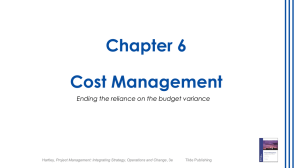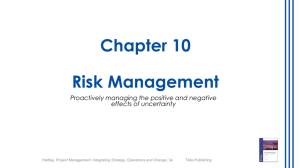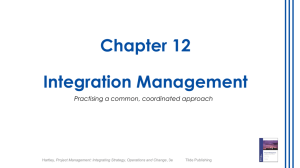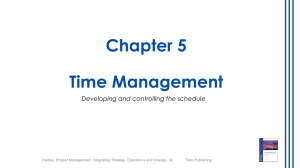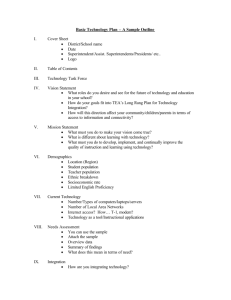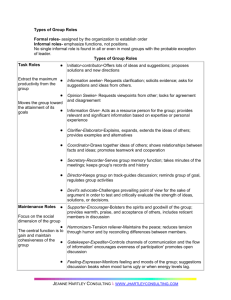Project Management
advertisement
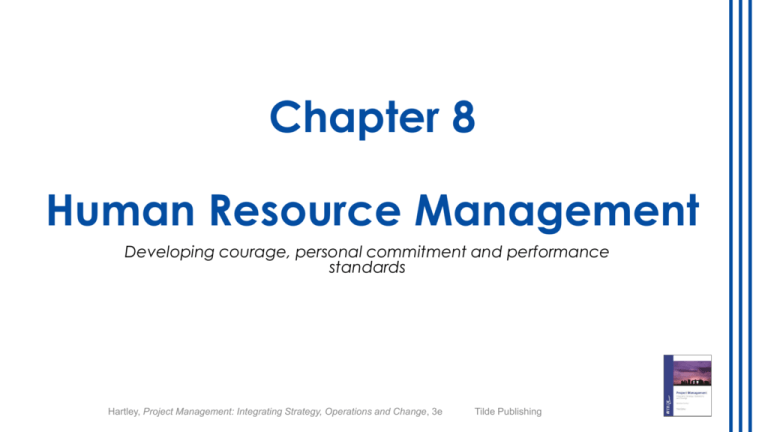
Chapter 8 Human Resource Management Developing courage, personal commitment and performance standards Hartley, Project Management: Integrating Strategy, Operations and Change, 3e Tilde Publishing Chapter overview 1. 2. 3. 4. 5. 6. 7. 8. Planning for human resource management Acquiring the project team Developing the team Teams and their personalities Learning and development opportunities Managing the project team Dealing with conflict Project organisational structures © 2014 Hartley, Project Management: Integrating Strategy, Operations and Change, 3e Tilde Publishing 2 Planning for human resource management The human resource management plan establishes the baseline for identifying the prerequisite resource needs (and necessary skills) for the project’s success. A well thought out resource management plan could contain: internal or external acquisition strategy roles and responsibilities acquisition and release timetables identification of professional development needs team building strategies plans for recognition and rewards performance management procedures © 2014 Hartley, Project Management: Integrating Strategy, Operations and Change, 3e Tilde Publishing 3 Acquiring the project team negotiating with operational managers to release or share resources investigating prevailing market conditions for availability and commercial rates for contractors reviewing preferred supplier arrangements communicating potential consequences to stakeholders on failing to acquire the necessary resources evaluating potential resources against the ambit of legal, regulatory, mandatory and/or other specific criteria covering their assignment considering the professional development plans for the nominated resources and how this time and cost will be addressed by the project budget factoring in the challenges of managing resources collocated in multiple locations each with different time zones and communication protocols determining how performance throughout the project will be measured and evaluated reflecting on the managers ability to manage a group of diverse resources brought together for a finite time span © 2014 Hartley, Project Management: Integrating Strategy, Operations and Change, 3e Tilde Publishing 4 Developing the team Forming – a room full of strangers Storming – cliques forming, turf wars developing Norming – work rhythm established Performing – balanced productivity and cohesion Adjourning – impending sense of loss and identity © 2014 Hartley, Project Management: Integrating Strategy, Operations and Change, 3e Tilde Publishing 5 Teams and their personalities People will bring their personalities to the project. Consideration should be given to understanding (and accepting) their: natural preferences for focusing their energy, gathering information, making decisions and living a certain way preferred way to respond to team challenges style of interacting and communicating with others unique way in how they make a distinctive contribution areas of strength and weakness in being on the team © 2014 Hartley, Project Management: Integrating Strategy, Operations and Change, 3e Tilde Publishing 6 Learning and development opportunities Resources need to be able to the technical knowledge that so often prescribes their learn, unlearn and relearn— and not just position description. The pool of knowledge, skills, insights, experience and information held by the team will need to be tapped and developed throughout the project. Learning shouldn’t be limited to just plugging the gaps, as it should also be about ‘…strengthening existing skills, identifying development opportunities and developing people for the future’ (Cole 2010). © 2014 Hartley, Project Management: Integrating Strategy, Operations and Change, 3e Tilde Publishing 7 Managing the project team Motivation o Maslow’s hierarchy of needs o Herzberg satisfaction and productivity This innate driving force will: o energise the team to complete their scheduled work o direct the team towards meeting deadlines, milestones and other constraints o draw the team together cohesively o enable the team to function in self-directed mode o allow the team to self-correct much of their own work. Performance management o developing and sustaining peak performance o five conversations © 2014 Hartley, Project Management: Integrating Strategy, Operations and Change, 3e Tilde Publishing 8 Dealing with conflict Forcing (win/lose) Avoiding (lose/lose) Accommodating (lose/win) Compromising (50/50) Collaborating (win/win) © 2014 Hartley, Project Management: Integrating Strategy, Operations and Change, 3e Tilde Publishing 9 Project organisational structures Functional o a traditional structure aligned with the existing organisational department or functions (in effect, an overlay of the existing organisational chart) Matrix o A blended structure supporting both the existing functional authority, priorities, performance and accountabilities with the (at times) competing and conflicting authority, priorities, performance and accountabilities from the project Projectised o a separate and discrete structure that technically sits outside the existing organisational structure with dedicated full-time resources assigned to the project © 2014 Hartley, Project Management: Integrating Strategy, Operations and Change, 3e Tilde Publishing 10 Review questions 1. Why is human resource management planning fundamental to the success of the project? 2. What information and decisions must be factored in to acquiring the project team? 3. How does the project manager help their team develop throughout the project? 4. Should conflict be viewed as a positive force in a project and how should it be dealt with? 5. What is the role of the performance review in contributing to peak project performance? © 2014 Hartley, Project Management: Integrating Strategy, Operations and Change, 3e Tilde Publishing 11 Group learning activities Discuss what value a human resource management plan would produce beyond an existing human resource department Discus the different strategies required to get the best out of any team Debate the notion that the underpinning theory behind team development often differs ‘in practice’ – Figure 8.1 Discuss why team performance measurement is crucial in developing the project team Identify areas in projects where conflict has created positive outcomes © 2014 Hartley, Project Management: Integrating Strategy, Operations and Change, 3e Tilde Publishing 12 Assessment options Develop a (one page) human resource management plan Create a checklist of skills, knowledge and/or attitudes required by a (generic) project team Develop a learning and development plan template for project resources Critique both Maslow and Herzberg’s theories of motivation as they apply to project management Write a report on the value of ongoing project performance management Evaluate each of the organisational structures and justify the choice made on a current project Short answer questions Multiple choice questions © 2014 Hartley, Project Management: Integrating Strategy, Operations and Change, 3e Tilde Publishing 13
